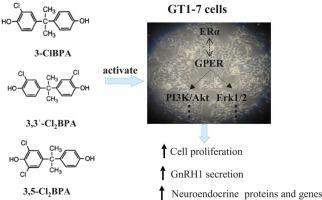Ecotoxicology and Environmental Safety ( IF 6.2 ) Pub Date : 2022-02-12 , DOI: 10.1016/j.ecoenv.2022.113290 Bingli Lei 1 , Lanbing Xu 1 , Yaoyao Huang 1 , Yun Liu 2 , Mengjie Yu 1 , Qianqian Tang 1

|
Chlorobisphenol A (ClxBPA) is a kind of novel estrogenic compounds. The present study aims to investigate the effects of three ClxBPA compounds on the kisspeptin/G protein-coupled receptor 54 (GPR54, also named KissR1)-gonadotropin-releasing hormone (GnRH) (KGG) system in neuronal GT1–7 cells with mechanistic insights by estrogen receptor signaling pathways. The study demonstrated that low-concentration ClxBPA induced the cell proliferation, promoted GnRH secretion, upregulated the expression of KGG neuroendocrine signal-related proteins (KissR1, GnRH1 and kisspeptin) and genes including Kiss1, GnRH1, KissR1, luteinizing hormone receptor (Lhr) and follicle-stimulating hormone receptor (Fshr) in GT1–7 cells. Additionally, ClxBPA activated nuclear estrogen receptor alpha (ERα) and member estrogen receptor G protein-coupled estrogen receptor (GPER)-regulated phosphatidylinositol-3-kinase/protein kinase B (PI3K/Akt) and extracellular signal-regulated kinase (Erk1/2) signaling pathways. Pretreatment of GT1–7 cells with GPER inhibitor G15 and ERα inhibitor ICI reduced the expression of KissR1, GnRH1 and kisspeptin proteins, attenuated mRNA levels of Kiss1, GnRH1, KissR1, Fshr and Lhr genes, and decreased ClxBPA-induced GT1–7 cell proliferation. The results suggested that ClxBPA activated the KGG neuroendocrine signals and induced the proliferation of GT1–7 cells via ERα and GPER signaling pathways. This study provides a new perspective to explore the neuroendocrine toxicity mechanism of ClxBPA.
Capsule
ClxBPA activated KGG neuroendocrine signaling pathway via ERα and GPER and induced the proliferation of GT1–7 cells.
中文翻译:

氯双酚 A 通过神经元 GT1-7 细胞中的 ERα 和 GPER 通路激活 Kisspeptin/GPR54-GnRH 神经内分泌信号
氯双酚A(Cl x BPA)是一种新型雌激素化合物。本研究旨在研究三种 Cl x BPA 化合物对神经元 GT1-7 细胞中的 Kisspeptin/G 蛋白偶联受体 54 (GPR54,也称为 KissR1)-促性腺激素释放激素 (GnRH) (KGG) 系统的影响。雌激素受体信号通路的机理见解。研究表明,低浓度Cl x BPA诱导细胞增殖,促进GnRH分泌,上调KGG神经内分泌信号相关蛋白(KissR1、GnRH1和kisspeptin)及Kiss1、GnRH1、KissR1、促黄体激素受体(Lhr )等基因的表达。) 和GT1-7 细胞中的促卵泡激素受体( Fshr )。此外,Cl x BPA 激活核雌激素受体 α (ERα) 和成员雌激素受体 G 蛋白偶联雌激素受体 (GPER) 调节的磷脂酰肌醇-3-激酶/蛋白激酶 B (PI3K/Akt) 和细胞外信号调节激酶 (Erk1 /2) 信号通路。用 GPER 抑制剂 G15 和 ERα 抑制剂 ICI 预处理 GT1-7 细胞可降低 KissR1、GnRH1 和 Kisspeptin 蛋白的表达,降低Kiss1、GnRH1、KissR1、Fshr和Lhr基因的 mRNA 水平,并降低 Cl xBPA 诱导的 GT1-7 细胞增殖。结果表明,Cl x BPA 通过 ERα 和 GPER 信号通路激活 KGG 神经内分泌信号并诱导 GT1-7 细胞增殖。本研究为探索Cl x BPA的神经内分泌毒性机制提供了新的视角。
胶囊
Cl x BPA 通过 ERα 和 GPER 激活 KGG 神经内分泌信号通路并诱导 GT1-7 细胞增殖。


















































 京公网安备 11010802027423号
京公网安备 11010802027423号